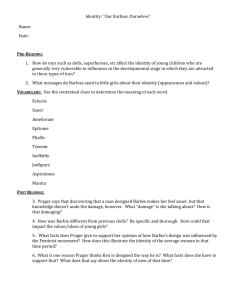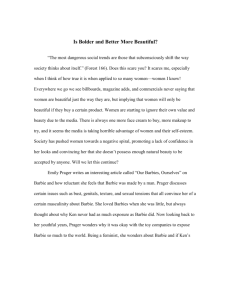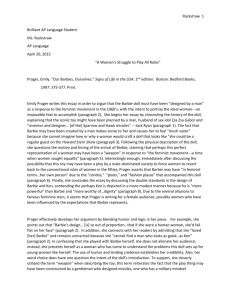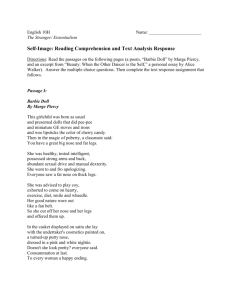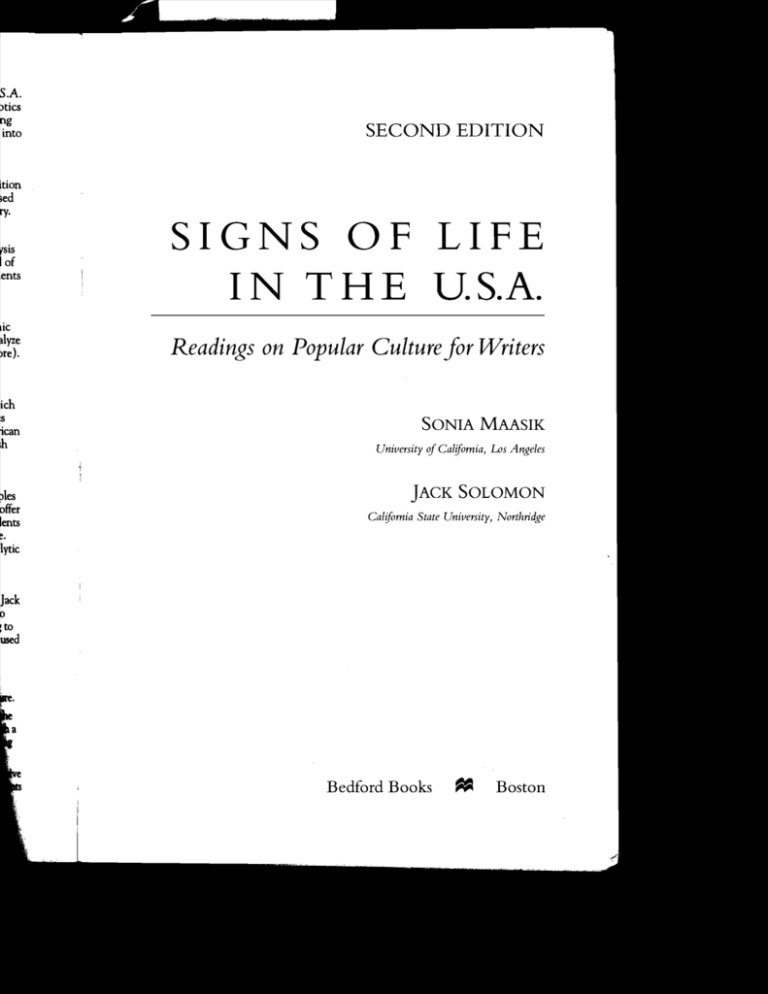
S.A.
)tics
ng
into
SECOND EDITION
ltion
ied
ry.
fSis
lof
ents
SIGNS OF LIFE
IN THE U.S.A.
lic
llyze
)re).
Readings on Popular Culture for Writers
ich
s
iean
h
)Ies
offer
lents
SONIA MAASIK
University of California, Los Angeles
JACK SOLOMON
California State University, Northridge
lytic
Jack
o
,to
~d
Bedford Books
~
Boston
We wish to dedicate this book to the memory
of our dear friend, Kenzo.
For Bedford Books
President and Publisher: Charles H. Christensen
General Manager and Assodate Publisher: Joan E. Feinberg
Managing Editor: Elizabeth M. Schaaf
Developmental Editor: Steven A. Scipione
Editorial Assistant: Rebecca Jennan
Production Editor: Sherri Frank
Copyeditor: Carolyn Ingalls
Text Design: Anna George
Cover Design: Hannus Design Associates
Cover Art: Tom Wesselmann, Still Life No. 28, 1964. © 1997 Tom Wesselmannl
Licensed by VAGA, New York, New York.
Library of Congress Catalog Card Number: 96-'i36776
Copyright © 1997 by Bedford Books
A Division of St. Martin's Press, Inc.
All rights reserved. No part of this book may be reproduced, stored in a retrieval sys­
tem, or transmitted by any fonn or by any means, electronic, mechanical, photocopy­
ing, recording, or otherwise, except as may be expressly permitted by the applicable
copyright statutes or in writing by the Publisher.
Manufactured in the United States of America.
10987 6
fedcba
For information, write: Bedford Books, 75 Arlington Street, Boston, MA 02116
(617-426-7440)
ISBN: 0-312-13631-5
Acknowledgments
McCrea Adams, "Advertising Characters: The Pantheon of Advertising." Reprinted by
pennission of the author.
(Acknowledgments and copyrights are continued at the back if the book on pages 784-789, which
constitute an extension of the copyright page. It is a violation of the law to reproduce these selec­
tions by any means whatsoever withom the written permission of the copyright holder.)
Thirty years ago, Mars}
era in the history of W!
gued in his classic stud)
new set of media - tc
sciousness was emergin!
passed since the publical
his predictions, especial
Today, ours is indeed a
visual image rather than
edge and experience has
This transformation
ture presents a certain
textually based enterpr
driven world? How are
ing? Can the habits of Cl
tasks of academic writin,
We have prepared;
only that such bridges co
our best hope for trainil
ing and writing. Thus, 1
one of helping students
our method departs fron
dents in the interpretatic
-THAN LIFE
lat they were
to something
sexual fantasy.
all, outside of
nan in Seduction
ihurst means by
. Batman is a gay
"And if I want
:the minds of his
n and Robin duo
~y arguing for or
nee closely. You
ley have file tapes
Batman, to gather
:lleski's analysis of
oticism in Batman
ow are any differ­
ie changes toward
mam's Seduction of
m's attack on Bat­
ld write an essay in
;ontag's "Notes on
erpretation and The
e character of Batwhat ways could a
Prager lOur 8arbies, Ourselves
375
EMILY PRAGER
Our Barbies, Ourselves
11111I111111111111111\1llllllillllllllllllllllllllllllllll
Little girls throughout America should know that Barbie is not drawn
to scale. In this tongue-in-cheek essay on the role Barbie has played in
her life, Emily Prager (b. 1952) reveals the damaging t1fect of a doll
that establishes such an impossible standard if physical peifection for
little girls - and for little boys who grow up expecting their girlfriends
to look like Barbie. Men not contemplating what Barbie has done to
her, Emily Prager is a columnist with the New York Times and an
essayist and fiction writer who has published for The National Lam­
poon, the Village Voice, and Penthouse, among other magazines.
Her books include a work if historicalfiction for children, W orId War
II Resistance Stories; a book if humor, The Official I Hate
Videogames Handbook; and works offiction such as Eve's Tattoo
(1991) and Clea and Zeus Divorce (1987).
I read an astounding obituary in the New York Times not too long
ago. It concerned the death of one Jack Ryan. A former husband of Zsa
Zsa Gabor, it said, Mr. Ryan had been an inventor and designer during
his lifetime. A man of eclectic creativity, he designed Sparrow and Hawk
missiles when he worked for the Raytheon Company, and, the notice
said, when he consulted for Mattel he designed Barbie.
If Barbie was designed by a man, suddenly a lot of things made sense
to me, things I'd wondered about for years. I used to look at Barbie and
wonder, What's wrong with this picture? What kind of woman designed
this doll? Let's be honest: Barbie looks like someone who got her start at
the Playboy Mansion. She could be a regular guest on The Howard Stem
Show. It is a fact of Barbie's design that her breasts are so out of propor­
tion to the rest of her body that if she were a human woman, she'd fall
flat on her face.
If it's true that a woman didn't design Barbie, you don't know how
much saner that makes me feel. Of course, that doesn't ameliorate the
damage. There are millions of women who are subliminally sure that a
thirty-nine-inch bust and a twenty-three-inch waist are the epitome of
lovability. Could this account for the popularity of breast implant
surgery?
I don't mean to step on anyone's toes here. I loved my Barbie. Se­
cretly, I still believe that neon pink and turquoise blue are the only colors
in which to decorate a duplex condo. And like many others of my gen­
eration, I've never married, simply because I cannot find a man who
looks as good in clam diggers as Ken.
376 Prager / Our E
LARGER THAN LIFE
The question that comes to mind is, of course, Did Mr. Ryan design
Barbie as a weapon? Because it is odd that Barbie appeared about the
same time in my consciousness as the feminist movement - a time when
women sought equality and small breasts were king. Or is Barbie the
dream date of weapons designers? Or perhaps it's simpler than that: Per­
haps Barbie is Zsa Zsa if she were eleven inches tall. No matter what, my
discovery ofJack Ryan confirms what I have always felt: There is some­
dare I say it, phallic. For
thing indescribably masculine about Barbie
all her giant breasts and high-heeled feet, she lacks a certain softness. If
you asked a little girl what kind of doll she wanted for Christmas, I just
don't think she'd reply, "Please, Santa, I want a hard-body."
On the other hand, you could say that Barbie, in feminist terms, is
definitely her own person. With her condos and fashion plazas and pools
and beauty salons, she is definitely a liberated woman, a gal on the move.
And she has always been sexual, even totemic. Before Barbie, American
dolls were flat-footed and breastless, and ineffably dignified. They were
created in the image of little girls or babies. Madame Alexander was the
queen of doll makers in the fifties, and her dollies looked like Elizabeth
Taylor in National Velvet. They represented the kind of girls who looked
perfect in jodhpurs, whose hair was never out of place, who grew up to
be Jackie Kennedy - before she married Onassis. Her dolls' boyfriends
were figments of the imagination, figments with large portfolios and
three-piece suits and presidential aspirations, figments who could keep
dolly in the style to which little girls of the fifties were programmed to
become accustomed, a style that spasm-ed with the sixties and the ap­
pearance of Barbie. And perhaps what accounts for Barbie's vast popular­
ity is that she was also a sixties woman: into free love and fun colors, an­
ticlass, and possessed of real, molded boyfriend, Ken, with whom she
could chant a mantra.
But there were problems with Ken. I always felt weird about him.
He had no genitals, and, even at age ten, I found that ominous. I mean,
here was Barbie with these humongous breasts, and that was OK with
the toy company. And then, there was Ken with that truncated, uniden­
tifiable lump at his groin. I sensed injustice at work. Why, I wondered,
was Barbie designed with such obvious sexual equipment and Ken not?
Why was his treated as if it were more mysterious than hers? Did the fact
that it was treated as such indicate that somehow his equipment, his es­
sential maleness, was considered more powerful than hers, more worthy
of the dignity of concealment? And if the issue in the mind of the toy
company was obscenity and its possible damage to children, I still object.
How do they think I felt, knowing that no matter how many water beds
they slept in, or hot tubs they romped in, or swimming pools they
lounged by under the stars, Barbie and Ken could never make love? No
matter how much sexuality Barbie possessed, she would never turn Ken
on. He would be forever withholding, forever detached. There was a
5
loneliness abc
twenty-five yl
women and CI
can never esca
God, it c<
signed by Jack
Reading ti
1. Why does.
Barbie was
2. What is Pn
3. HowdoM
Reading th
1. Bring a toy
cance; you
tended for 1
and present
related patte
2. Think ofa 1
tion of it, u
between YOI
3. Did you hal
entry in wh
young and t
4. Consider he
Write a lette
tity Barbie's
5. Barbie can I
roles but als(
sories" one I
plore the ex
by Laurence
Prager JOur Barbies, Ourselves
~N LIFE
an design
lbout the
me when
arbie the
that: Perwhat, my
~ IS some­
lallic. For
oftness. If
nas, 1 just
terms, is
and pools
the move.
American
~hey were
er was the
Elizabeth
holooked
;rew up to
boyfriends
folios and
ould keep
'ammed to
Id the ap­
,t popularcolors, anwhom she
t
tbout him.
I mean,
; OK with
d, uniden­
wondered,
i Ken not?
)id the fact
ent, hi~ es­
~re worthy
of the toy
still object.
water beds
pools they
;.:e love? No
'er tum Ken
IS.
5
317
loneliness about Barbie's situation that was always disturbing. And
twenty-five years later; movies and videos are still filled with topless
women and covered men. As if we're all trapped in Barbie's world and
can never escape.
God, it certainly has cheered me up to think that Barbie was de­
signed by Jack Ryan....
Reading the Text
1. Why does Prager say "a lot of things made sense" to her after she learned
Barbie was designed by a man?
2. What is Prager's attitude toward Ken?
3. How do Madame Alexander dolls differ from Barbies?
Reading the Signs
1. Bring a toy to class and, in same-sex groups, discuss its semiotic signifi­
cance; you may want to focus particularly on how the toys may be in­
tended for one gender or another. Then have each group select one toy
and present your interpretation of it to the whole class. What gender­
related patterns do you find in the presentations?
2. Think of a toy you played with as a child and write a semiotic interpreta­
tion of it, using Prager's essay as a model. Be sure to consider differences
between your childhood response to the toy and your current response.
3. Did you have a Barbie doll when you were a child? If so, write a journal
entry in which you explore what the doll meant to you when you were
young and how Prager's essay has caused you to rethink your attitudes.
4. Consider how Jack Ryan, the creator of Barbie, would defend his design.
Write a letter, as if you were Ryan, addressed to Prager in which you jus­
tifY Barbie's appearance and refute Prager's analysis.
5. Barbie can be seen as embodying not only America's traditional gender
roles but also its consumerist ethos. Visit a toy store to learn what "acces­
sories" one can buy for Barbie and then write an essay in which you ex­
plore the extent to which she illustrates the "hunger for more" described
by Laurence Shames (see "The More Factor," p. 31).

